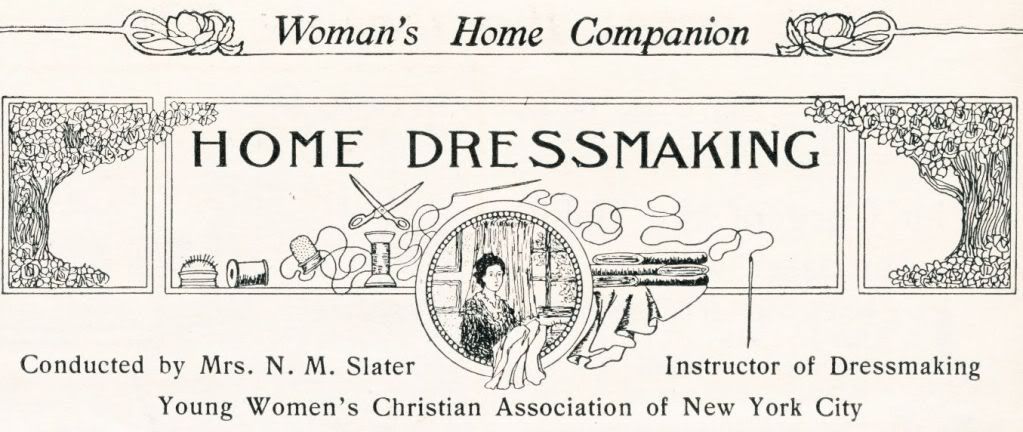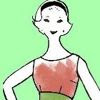

EDITOR DRESSMAKING DEPARTMENT:- I bought a dark blue and white foulard gown this summer with the idea of not only wearing it throughout the summer, but of using it as all after-noon and evening gown during the fall and winter. I had the misfortune to spill a bottle of ink over the front breadth which has utterly ruined it. Is there any way I can fix the skirt so that it will look all right again?
MRS. BELLE H.
ANSWER TO MRS BELLE H.- Yes indeed. Carry out the following directions and you will see how successfully it call be done. Cut a front gore, extending into a yoke, from green silk or satin, the proper shade to harmonize with your blue. Cover this with Irish lace. Cut the lace along the pattern on the lower edge of the yoke and down the side of the gore, and cut and turn under the silk on the same outline, and sew invisibly. Pipings are to be used this fall, and one of green velvet would be pretty outlining the yoke and the front breadth. Into your flounce set inlets of lace, four inches square, piped with green velvet. Set these in diagonally about ten inches apart. Place a strap of velvet three fourths of an inch wide, pointed at each end, from the lower point and along the lower edge of each inlet to the upper edge and upper point of its right-hand neighbor. It is too bad to have to remodel the waist to make it match the skirt, but there is no other way. Make the yoke and collar of lace over the green silk, and pipe the edge with velvet the same as the yoke of the skirt. Use lace inlets in the sleeves, with pipings and straps, but making them smaller than in the flounce. Make a pointed belt of green velvet as illustrated.

EDITOR DRESSMAKING DEPARTMENT:-Will you please give me careful directions for making a separate waist, one which will wear well? I would like something which would be useful for traveling and every-day wear generally.
J. H. G., Denver.
ANSWER TO J. H. G.-Select brilliantine as the material for your serviceable waist. Buy a good quality in either blue, gray or black. The model shown on this page is an attractive one to copy. Silver-gray brilliantine was used, and the waist was cut after a modification of the popular, Gibson style. For such a waist two and one half yards of material are enough. For cutting, place the center fronts on the selvage, the center back of the lengthwise fold, and the center of the sleeve straight on a lengthwise thread of the goods. The line of perforation in the pattern that indicates the plait over the shoulder must be accurately marked on the goods. On material that does not show the print of the tracing-wheel the marking may first be done through the perforation with chalk, and afterward with lines of basting. The making of the Gibson waist differs from others in this respect. The shoulder-seams are stitched, pressed open flat, then stitched on right side one fourth of an inch on either side of the seam. The plaits are then taken up, following the tracings exactly. Baste underarm seams, and fit, but do not make it snug under the arms. The fronts are closed with a fly, and the box-plait is trimmed with stitch arrow-heads, which are put on separately. After the waist has been fitted, unbaste the under-arm seams and stitch on the arrow-heads, Begin at the waist-line in the back, between the center of back and the plait, and let the arrow-head end in front at the bust-line. All the arrow-heads should be cut on the bias; but do not cut them until you are ready to use them, as brilliantine frays very quickly. Turn the edges in and baste carefully with short stitches before basting to the waist. The stitching must must be perfectly done. Close the under-arm seams, and bind the seam-edges. The neck-band should be silk or lined with it. A pretty stock may be made of the material, with an arrow-head turned over each side of the front, and closing under another in the back. The cuff closes with an arrow-head finish. The waist may be lined with lawn if lining is preferred, though it is not absolutely necessary.

EDITOR DRESSMAKING DEPARTMENT:- I have a black brocaded satin dress that was made four years ago. The material is good, but the skirt is too narrow at the bottom. Can you tell me of some way to make it wider? It was bought ready-made, and I have no more material like it. The waist is a shirred waist, and is not like the skirt, as I bought the cloth and had it made. I think the sleeves are about as they make them now, and the waist has a yoke in the back, and the lower part is in variated plaits. Is there any suggestion you can make in regard to changing the waist, or would you wear it as it is?
MRS. L.H. MATHEWS, APALACHIN, N.Y.
ANSWER TO MRS. L.H. MATHEWS, -Your brocaded drop-skirt may easily be made to flare at the foot by setting in on each side of the skirt three box-plaited sections of a heavy, large-mesh black net. If the skirt is seven-gored set one in each seam. If the skirt is cut in any other way put the box-plaits at even distances from the front seam. Take a piece of net twelve inches wide and twenty inches long, make a two-inch at the foot, and trim with two stitched straps of taffeta. Arrange the net in three box-plaits, and apply to the skirt with a lattice of stitched straps, as shown in illustration. The shirt-waist you mention is not in the present style; but as yokes are coming in again, it might be well to lay it aside until fall, when it may be all right. In the meantime wear a dainty white waist with the skirt.


"Pipings are to be used this fall"
ReplyDeleteYes ma'am!
And " The stitching must must be perfectly done."
ReplyDeleteSuch wonderful ideas to put against the present throw-away world!
ReplyDeleteFascinating! I hadn't come across the term "waist" as used here before. Perhaps "waistcoat" is related to this usage rather than just being a coat-like thing that only reaches the waist.
ReplyDeleteI love the precise information on how to make these alterations - and the implication that garments were far more valuable than now, when people would most likely throw out a stained dress rather than putting many hours of work into remodelling it.